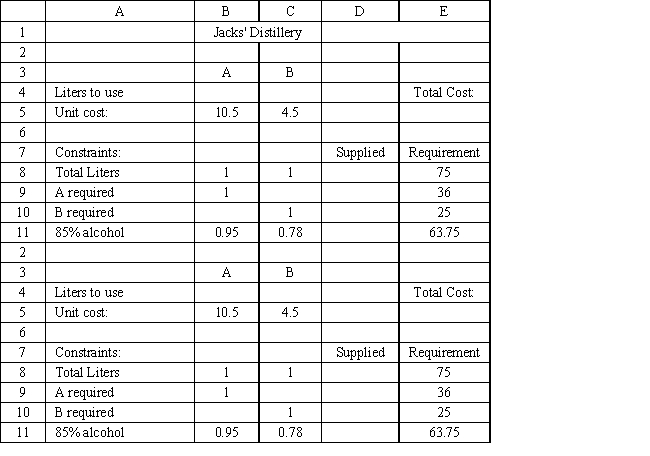Exhibit 3.3
The following questions are based on this problem and accompanying Excel windows.
Jack's distillery blends scotches for local bars and saloons. One of his customers has requested a special blend of scotch targeted as a bar scotch. The customer wants the blend to involve two scotch products, call them A and B. Product A is a higher quality scotch while product B is a cheaper brand. The customer wants to make the claim the blend is closer to high quality than the alternative. The customer wants 50 1500 ml bottles of the blend. Each bottle must contain at least 48% of Product A and at least 500 ml of B. The customer also specified that the blend have an alcohol content of at least 85%. Product A contains 95% alcohol while product B contains 78%. The blend is sold for $12.50 per bottle. Product A costs $7 per liter and product B costs $3 per liter. The company wants to determine the blend that will meet the customer's requirements and maximize profit. 

-Refer to Exhibit 3.3. Which cells should be changing cells in this problem?
Definitions:
Diploid
Having two complete sets of chromosomes, one from each parent.
Visual
Refers to elements that are perceptible by the eye, used in various media and presentations to enhance understanding and engagement.
Emphasized
Given special importance, prominence, or stress in speaking or writing.
Comparative Contribution
An assessment or discussion regarding the respective inputs or impacts of different factors or participants.
Q4: A major argument in favor of setting
Q4: Which of the following categories of modeling
Q5: Which of the following pair of countries
Q10: Project 1.2<br>Assignment: Conduct a search of Internet
Q15: According to the IASB,<br>A) the cost method
Q19: Segment reviews of operations on a geographical
Q28: Chapter One discussed all of the following
Q36: Trade unions are not one of the
Q63: An oil company wants to create lube
Q74: Refer to Exhibit 9.2.Interpret the meaning of